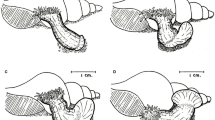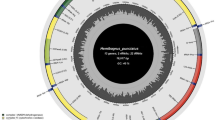Abstract
The Ukrainian brook lamprey Eudontomyzon mariae is the most widespread lamprey species in eastern Europe. Although E. mariae is generally considered a derivative of Eudontomyzon danfordi, an exclusively freshwater parasitic species, it has alternatively been suggested that it was recently derived from a now extinct anadromous Black Sea ancestor. Several non-parasitic lampreys and the landlocked sea lamprey, which have recently evolved from anadromous ancestors, still develop a seawater-type mitochondria-rich cell (SW-MRC) in their gills. In contrast, this cell type is not present in the gills of either Lampetra aepyptera, a non-parasitic lamprey of ancient origin, or the parasitic Ichthyomyzon unicuspis and I. castaneus that likewise have long evolutionary histories in fresh water. Eudontomyzon mariae from the Vistula River in the Baltic River basin does not possess SW-MRC, which is inconsistent with a recent origin from an anadromous ancestor. Mitochondrial DNA sequence data were thus used to infer the relationship between different populations of E. mariae and E. danfordi, and to reconstruct the transition from anadromy to freshwater residency. The results suggest that E. mariae evolved independently in the Baltic, Black, and Caspian Sea basins, and not recently from an anadromous ancestor. Although E. mariae in the Danube River may have arisen relatively recently from E. danfordi (differing by 0.7–1.1% in cytochrome b gene sequence), other E. mariae populations (including in the Vistula River) are genetically closer (0.6%) to the hypothetical ancestor of both E. mariae and E. danfordi. That ancestor was probably a freshwater resident, since SW-MRCs are not rapidly lost following confinement in fresh water.




Similar content being viewed by others
References
April J, Mayden RL, Hanner RH, Bernatchez L (2011) Genetic calibration of species diversity among North America’s freshwater fishes. Proc Natl Acad Sci U S A 108:10602–10607
Bandelt H-J, Forster P, Röhl A (1999) Median-joining networks for inferring intraspecific phylogenies. Mol Biol Evol 16:37–48
Bartels H, Potter IC (1991) Structural changes in the zonulae occludentes of the chloride cells of young adult lampreys following acclimation to seawater. Cell Tissue Res 265:447–457
Bartels H, Potter IC (2004) Cellular composition and ultrastructure of the gill epithelium of larval and adult lampreys. Implications for osmoregulation in fresh and seawater. J Exp Biol 207:3447–3462
Bartels H, Fazekas U, Youson JH, Potter IC (2011) Changes in the cellular composition of the gill epithelium during the life cycle of a nonparasitic lamprey. Functional and evolutionary implications. Can J Zool 89:538–545
Bartels H, Docker MF, Fazekas U, Potter IC (2012) Functional and evolutionary implications of the cellular composition of the gill epithelium of feeding adults of a freshwater parasitic species of lamprey, Ichthyomyzon unicuspis. Can J Zool 90:1278–1283
Bartels H, Docker MF, Krappe M, White MW, Wrede C, Potter IC (2015) Variations in the presence of chloride cells in the gills of lampreys (Petromyzontiformes) and their evolutionary implications. J Fish Biol 86:1421–1428
Beamish FWH (1980) Osmoregulation in juvenile and adult lampreys. Can J Fish Aquat Sci 37:1739–1750
Blank M, Jurss K, Bastrop R (2008) A mitochondrial multigene approach contributing to the systematics of the brook and river lampreys and the phylogenetic position of Eudontomyzon mariae. Can J Fish Aquat Sci 65:2780–2790
Boguski DA, Reid SB, Goodman DH, Docker MF (2012) Genetic diversity, endemism and phylogeny of lampreys within the genus Lampetra sensu stricto (Petromyzontiformes: Petromyzontidae) in western North America. J Fish Biol 81:1891–1914
Bracken FS, Hoelzel AR, Hume JB, Lucas MC (2015) Contrasting population genetic structure among freshwater-resident and anadromous lampreys: the role of demographic history, differential dispersal and anthropogenic barriers to movement. Mol Ecol 24:1188–1204
Bryan MB, Zalinski D, Filcek KB, Libants S, Li W, Scribner KT (2005) Patterns of invasion and colonization of the sea lamprey (Petromyzon marinus) in North America as revealed by microsatellite genotypes. Mol Ecol 14:3757–3773
Dawson HA, Quintella BR, Almeida PR, Treble AJ, Jolley JC (2015) The ecology of larval and metamorphosing lampreys. In: Docker MF (ed) Lampreys: biology, conservation and control, vol 1. Springer, Dordrecht, pp 75–137
Docker MF (2009) A review of the evolution of nonparasitism in lampreys and an update of the paired species concept. Am Fish Soc Symp 72:71–114
Docker MF, Youson JH, Beamish RJ, Devlin RH (1999) Phylogeny of the lamprey genus Lampetra inferred from mitochondrial cytochrome b and ND3 gene sequences. Can J Fish Aquat Sci 56:2340–2349
Eshenroder RL (2014) The role of the Champlain Canal and Erie Canal as putative corridors for colonization of Lake Champlain and Lake Ontario by sea lampreys. Trans Am Fish Soc 143:634–649
Espanhol R, Almeida PR, Alves MJ (2007) Evolutionary history of lamprey paired species Lampetra fluviatilis (L.) and Lampetra planeri (Bloch) as inferred from mitochondrial DNA variation. Mol Ecol 16:1909–1924
Ferreira-Martins D, Coimbra J, Antunes C, Wilson JM (2016) Effects of salinity on upstream-migrating, spawning sea lamprey, Petromyzon marinus. Conserv Physiol 4: doi:10.1093/conphys/cov064
Freyhof J, Kottelat M (2008) Eudontomyzon sp. nov. ‘migratory’. The IUCN Red List of Threatened Species 2008: e.T135505A4134478. http://dx.doi.org/10.2305/IUCN.UK.2008.RLTS.T135505A4134478.en. Downloaded on 11 May 2016
Galtier N, Nabholz B, Glémin S, Hurst GDD (2009) Mitochondrial DNA as a marker of molecular diversity: a reappraisal. Mol Ecol 17:4541–4550
Hardisty MW (1986) Lampetra planeri (Bloch, 1784). In: Holčík J (ed) The freshwater fishes of Europe, vol.1, Part I Petromyzontiformes, vol 1. AULA-Verlag, Wiesbaden, pp 279–304
Hiroi J, McCormick SD (2012) New insights into gill ionocyte and ion transporter function in euryhaline and diadromous fish. Respir Physiol Neurobiol 184:257–268
Holčík J, Renaud CB (1986) Eudontomyzon mariae (Berg, 1931). In: Holčík J (ed) The freshwater fishes of Europe, vol.1, Part I Petromyzontiformes, vol 1. AULA-Verlag, Wiesbaden, pp 165–185
Karnaky KJ Jr (1986) Structure and function of the chloride cell of Fundulus heteroclitus and other teleosts. Am Zool 26:209–224
Kottelat M, Bogutskaya NG, Freyhof J (2005) On the migratory Black Sea lamprey and the nomenclature of the ludoga, Peipsi and ripus whitefishes (Agnatha: Petromyzontidae; Teleostei: Coregonidae). Zoosyst Rossica 14:181–186
Lang NJ, Roe KJ, Renaud CB, Gill HS, Potter IC, Freyhof J, Naseka AM, Cochran P, Espinosa Pérez H, Habit EM, Kuhajda BR, Neely DA, Reshetnikov YS, Salnikov VB, Stoumboudi MT, Mayden RL (2009) Novel relationships among lampreys (Petromyzontiformes) revealed by a taxonomically comprehensive molecular data set. Am Fish Soc Symp 72:41–55
Levin B, Ermakov A, Ermakov O, Levina M, Sarycheva O, Sarychev V (2016) Ukrainian brook lamprey Eudontomyzon mariae (Berg): phylogenetic position, genetic diversity, distribution, and some data on biology. In: Orlov A, Beamish R (eds) Jawless fishes of the world, vol 1. Cambridge Scholars Publishing, Newcastle Upon Tyne, pp 58–82
Li Y (2014) Phylogeny of the lamprey genus Lethenteron Creaser and Hubbs 1922 and closely related genera using the mitochondrial cytochrome b gene and nuclear gene introns. MSc thesis, Department of Biological Sciences, The University of Manitoba, Winnipeg, MB
Librado P, Rozas J (2009) DnaSP v5: a software for comprehensive analysis of DNA polymorphism data. Bioinformatics 25:1451–1452
Manzon RG, Youson JH, Holmes JA (2015) Lamprey metamorphosis. In: Docker MF (ed) Lampreys: biology, conservation and control, vol 1. Springer, Dordrecht, pp 139–214
Mateus CS, Almeida PR, Mesquita N, Quintella BR, Alves MJ (2016) European lampreys: new insights on postglacial colonization, gene flow and speciation. PLoS ONE 11(2):e014107. doi:10.1371/journal.pone.0148107
Morris R (1972) Osmoregulation. In: Hardisty MW, Potter IC (eds) The biology of Lampreys, vol 2. Academic Press, London, pp 192–239
Peek WD, Youson JH (1979) Transformation of the interlamellar epithelium of the gills of the anadromous sea lamprey, Petromyzon marinus L., during metamorphosis. Can J Zool 57:1318–1332
Potter IC (1980) The Petromyzoniformes with particular reference to paired species. Can J Fish Aquat Sci 37:1595–1615
Potter IC, Gill HS, Renaud CB, Haoucher D (2015) The taxonomy, phylogeny and distribution of Lampreys. In: Docker MF (ed) Lampreys: biology, conservation and control, vol 1. Springer, Dordrecht, pp 35–74
Reis-Santos P, McCormick SD, Wilson JM (2008) Ionoregulatory changes during metamorphosis and salinity exposure of juvenile sea lamprey (Petromyzon marinus L.). J Exp Biol 211:978–988
Renaud CB (1982) Revision of the lamprey genus Eudontomyzon Regan, 1911. MSc thesis, University of Ottawa, Ottawa, ON
Renaud CB (2011) Lampreys of the world. An annotated and illustrated catalogue of lamprey species known to date. FAO Species Catalogue for Fishery Purposes. No. 5. Rome, FAO. 109 pp
Rougemont Q, Gaigher A, Lasne E, Côte J, Coke M, Besnard A-L, Launey S, Evanno G (2015) Low reproductive isolation and highly variable levels of gene flow reveal limited progress towards speciation between European river and brook lampreys. J Evol Biol 28:2248–2263
Rougemont Q, Roux C, Neuenschwander S, Goudet J, Launey S, Evanno G (2016) Reconstructing the demographic history of divergence between European river and brook lampreys using approximate Bayesian computations. PeerJ 4:e1910. doi:10.7717/peerj.1910
Rougemont Q, Gaigher P-A, Perrier C, Genthon C, Besnard A-L, Launey S, Evanno G (2017) Inferring the demographic history underlying parallel genomic divergence among pairs of parasitic and nonparasitic lamprey ecotypes. Mol Ecol 26:142-162
Stetter MD (2001) Fish and amphibian anesthesia. Vet Clin North Am Exot Anim Pract 4:69–82
Tamura K, Stecher G, Peterson D, Filipski A, Kumar S (2013) MEGA6: molecular evolutionary genetics analysis version 6.0. Mol Biol Evol 30:2725–2729
Waldman JR, Grunwald C, Roy NK, Wirgin II (2004) Mitochondrial DNA analysis indicates sea Lampreys are indigenous to Lake Ontario. Trans Am Fish Soc 133:950–960
Youson JH, Beamish RJ (1991) Comparison of the internal morphology of adults of a population of lampreys that contains a nonparasitic life-history type, Lampetra richardsoni, and a potentially parasitic form, L. richardsoni var. marifuga. Can J Zool 69:628–637
Youson JH, Freeman PA (1976) Morphology of the gills of larval and parasitic adult sea lamprey, Petromyzon marinus L. J Morphol 149:73–104
Acknowledgements
The authors thank Claude B. Renaud for critically reading the manuscript. The excellent technical assistance of S. Fassbaender is gratefully acknowledged. A. Fox provided help with the network analyses. Financial support was provided by the Natural Sciences and Engineering Research Council of Canada, the Faculty of Science at the University of Manitoba, Murdoch University and the Polish Ministry for Science and Higher Education.
Author information
Authors and Affiliations
Corresponding author
Ethics declarations
The study was in accordance with the Polish law of animal welfare.
Conflict of interests
The authors declare no conflict of interest.
Rights and permissions
About this article
Cite this article
Bartels, H., Wrede, C., Przybylski, M. et al. Implications of absence of seawater-type mitochondria-rich cells and results of molecular analyses for derivation of the non-parasitic Ukrainian brook lamprey Eudontomyzon mariae . Environ Biol Fish 100, 509–518 (2017). https://doi.org/10.1007/s10641-017-0581-6
Received:
Accepted:
Published:
Issue Date:
DOI: https://doi.org/10.1007/s10641-017-0581-6




